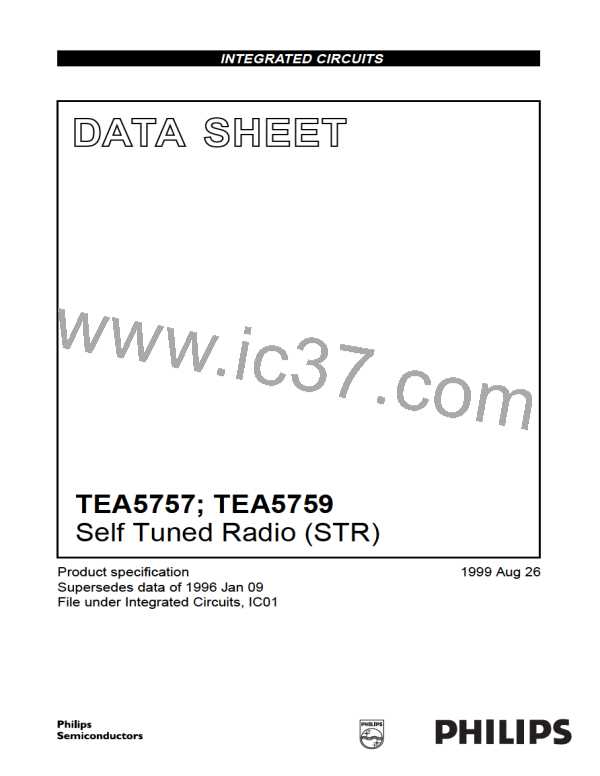Philips Semiconductors
Product specification
Self Tuned Radio (STR)
TEA5757; TEA5759
FUNCTIONAL DESCRIPTION
2. The Automatic Frequency Control (AFC) is
switched off.
The TEA5757; TEA5759 is an integrated AM/FM stereo
radio circuit including digital tuning and control functions.
3. The counter starts counting the frequency and the
tuning voltage is varied until the desired frequency
roughly equals the real frequency.
The radio
4. The AFC is then switched on and the counter is
switched off.
The AM circuit incorporates a double balanced mixer,
a one-pin low-voltage oscillator (up to 30 MHz) and is
designed for distributed selectivity.
5. The real frequency is more precisely tuned to the
desired frequency.
The AM input is designed to be connected to the top of
a tuned circuit. AGC controls the IF amplification and for
large signals it lowers the input impedance of the
AM front-end.
After the AFC has tuned the real frequency to the desired
frequency an in-lock signal can be generated. In order to
get a reliable in-lock signal, there are two parameters
measured: the field strength and the S-curve. The field
strength indicates the strength of the station and by
looking at the S-curve the system can distinguish false
in-locks from real in-locks (false in-locks occur on the
wrong slope of the S-curve).
The first AM selectivity can be an IF-Tank (IFT) as well as
an IFT combined with a ceramic filter; the second one is
an IFT.
The FM circuit incorporates a tuned RF stage, a double
balanced mixer, a one-pin oscillator and is designed for
distributed IF ceramic filters. The FM quadrature detector
uses a ceramic resonator (or LC).
In the event of fading or pulling the in-lock signal becomes
logic 0 and the synthesizer will be switched on again and
the algorithm will be repeated.
The PLL stereo decoder incorporates a signal dependent
stereo-blend circuit and a soft-mute circuit.
SEARCH OPERATION
During a search operation, the only action the
Tuning
microcontroller has to take is: sending the desired band
plus the direction and the search sensitivity level to the
STR. The search operation is performed by the charge
pump until an in-lock signal is generated (combination of
measuring the field strength and the S-curve). The AFC
then fine tunes to the station. The frequency belonging to
the found station will be counted by the counter and written
into the last-station memory and the shift register of the
counter. At this time the frequency is available in the shift
register and can be read by the microcontroller.
The microcontroller decides whether the frequency is
within the desired frequency band. If so, this frequency can
be stored under a preset and if not, a new search action
should be started.
The tuning concept of the Self Tuned Radio (STR) is
based on FUZZY LOGIC: it mimics hand tuning (hand
tuning is a combination of coarse and fine tuning to the
qualitatively best frequency position). As a consequence
the tuning system is very fast.
The tuning algorithm, which is controlled by the sequential
circuit (see Fig.1), is completely integrated; so there are
only a few external components needed.
The bus and the microcontroller can be kept very simple.
The bus only consists of three wires (BUS-CLOCK, DATA
and WRITE-ENABLE). The microcontroller must basically
give two instructions:
• Preset operation
• Search operation.
To ensure that the search function operates correctly
under all conditions the following search sequence must
be applied:
PRESET OPERATION
• Store the current frequency in the memory
• Issue the search command
In preset mode, the microcontroller has to load information
such as frequency band, frequency and mono/stereo. This
information has to be sent via the bus to the STR.
The internal algorithm controls the tuning sequence as
follows:
• Wait for data valid and read the new frequency
• If the new frequency is the same as the stored
frequency, issue a pre-set step (e.g. 50 kHz) and start
the search sequence again.
1. The information is loaded into the shift register, the
last-station memory and the counter.
1999 Aug 26
7

 NXP [ NXP ]
NXP [ NXP ]